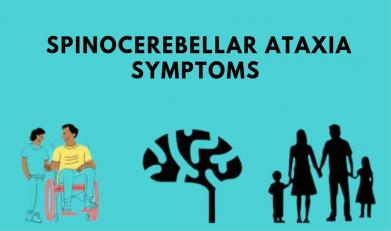Spinocerebellar ataxia (SCA) is a group of inherited, progressive neurological disorders that primarily affect the cerebellum—the part of the brain responsible for coordinating movement and balance. As the disease progresses, it can also impact the spinal cord and other regions of the central nervous system, leading to a diverse and complex array of symptoms. The hallmark of SCA is ataxia, a term used to describe a lack of coordination and control over voluntary movements. However, the symptoms of SCA extend beyond just ataxia, encompassing various physical, speech, and cognitive challenges. Understanding these symptoms is crucial for early diagnosis, effective management, and providing appropriate support to those affected by this debilitating condition.
Key Symptoms of Spinocerebellar Ataxia
Ataxia:
- Gait Ataxia: One of the earliest and most common symptoms is an unsteady gait. Individuals with SCA often experience difficulty walking, frequent stumbling, and a wide-based, uncoordinated walking pattern.
- Limb Ataxia: This includes poor coordination of the arms and legs, making tasks like writing, buttoning a shirt, or picking up objects challenging.
Dysarthria:
- This is a speech disorder characterized by slow, slurred, and sometimes difficult-to-understand speech due to a lack of coordination in the muscles used for speaking.
Nystagmus:
- Involuntary, rapid eye movements, which can cause vision problems such as difficulty focusing, blurred vision, or double vision.
Dysphagia:
- Difficulty swallowing, which can lead to choking, aspiration pneumonia, and weight loss.
Muscle Weakness and Atrophy:
- Over time, individuals with SCA may experience muscle weakness and wasting, particularly in the extremities, affecting their ability to perform everyday tasks.
Spasticity:
- Increased muscle tone and stiffness, leading to difficulty with movement and coordination.
Tremors:
- Shaking or tremors in the hands, arms, or other parts of the body, which can worsen with purposeful movement (intention tremor).
Cognitive Impairments:
- Some forms of SCA can be associated with cognitive difficulties, including problems with memory, attention, and executive function.
Peripheral Neuropathy:
- Damage to the peripheral nerves, resulting in symptoms such as numbness, tingling, pain, and weakness, typically in the hands and feet.
Autonomic Dysfunction:
In some cases, SCA can affect the autonomic nervous system, leading to problems with bladder and bowel control, blood pressure regulation, and heart rate.
Variability in Symptoms
The symptoms of SCA can vary widely depending on the specific type of SCA and the individual. Some types of SCA are more likely to present with certain symptoms than others. For instance, SCA3 (also known as Machado-Joseph disease) often includes a combination of ataxia, spasticity, and peripheral neuropathy, while SCA6 tends to primarily affect balance and coordination.
The age of onset can also vary, with some individuals showing symptoms in childhood or adolescence, while others may not develop symptoms until middle age or later. The rate of progression can be slow or rapid, impacting the severity and combination of symptoms experienced.
Impact on Daily Life
Living with SCA can significantly affect an individual's quality of life. The progressive nature of the disorder means that symptoms typically worsen over time, leading to increasing disability. Challenges with mobility, speech, and daily activities can affect independence, social interactions, and emotional well-being.
Management and Support
While there is currently no cure for SCA, various treatments and interventions can help manage symptoms and improve quality of life. These may include:
-
Physical Therapy: To improve strength, coordination, and balance, and to develop strategies for maintaining mobility.
-
Occupational Therapy: To assist with daily living activities and adaptive techniques or devices to enhance independence.
-
Speech Therapy: To address speech and swallowing difficulties, helping improve communication and reduce the risk of aspiration.
-
Medications: To manage specific symptoms such as muscle spasticity, tremors, and neuropathic pain.
-
Assistive Devices: Such as walkers, wheelchairs, and communication aids, to support mobility and communication.
-
Support Groups and Counseling: To provide emotional support, coping strategies, and connection with others facing similar challenges.
Conclusion
Spinocerebellar ataxia (SCA) is a multifaceted disorder characterized by a range of symptoms that affect coordination, balance, speech, and more. The progressive nature of SCA means that symptoms often worsen over time, significantly impacting the quality of life for those affected. While there is currently no cure, understanding the specific symptoms and their progression is essential for managing the disorder and improving patient outcomes. Through targeted therapies, adaptive strategies, and supportive care, individuals with SCA can navigate the challenges of the disorder and maintain a better quality of life. Ongoing research continues to offer hope for new treatments and a deeper understanding of this complex condition, aiming to enhance the lives of those living with SCA.

